Michigan Resident Lawyer Employment Data - Part 6

Michigan Resident Lawyer Employment Data–Part 6 by Don LeDuc, Professor of Law, Cooley Law School
Annually, the State Bar of Michigan collects detailed data regarding its membership, focusing on active Michigan resident lawyers–a focus followed in the seven-part analysis in this series. The data is supplied by and used with the permission of the State Bar. My thanks to Kristen Sewell, the current Research and Analytics Director at the State Bar of Michigan and Anne Vrooman, recently retired from that position, for their work in gathering and providing this information. The data provides an opportunity to examine objectively both the changes from year-to-year and the implications of those changes.
Part 6–Active Michigan Resident Lawyers by Department of Transportation Region: The Office of Economic Development within the Michigan Department of Transportation divides the state into seven regions, giving each region an identifying title. Chart 9 and 10 contain two changes in this approach: (1) what the Office calls the North region is divided into two geographical regions, which are given new names–Northeast (with 11 counties) and Northwest (with 10 counties); (2) the titles of the regions have been changed.
Regional constructs in Michigan vary by developer and substantive focus, but generally include factors such as commuting time and ease of travel to major cities, economic and employment considerations, and access to secondary schools, colleges, and universities. Access to health care may be a focus in some regional planning.
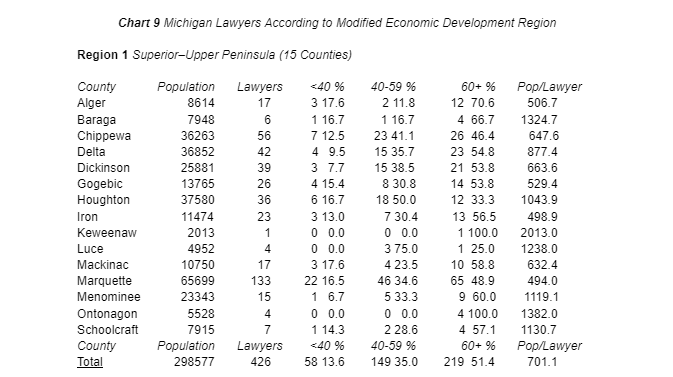
Region 1, comprising Michigan’s upper peninsula, is the largest in land area and second-smallest in population (given this report’s division of the OED Northern region in half). This region has the highest ratio of population to lawyer in the state; seven of its counties have more than 1,000 persons per lawyer–one has more than 2,000. Among the regions, Region 1 has the second-lowest number of both lawyers and lawyers under age 40. Three of its 15 counties have no lawyers under age 40 (two have no lawyer under age 60) and 3 others have only one lawyer under age 40. Over half of this region’s lawyers are aged 60 or over.
Region 1 has three public universities: Michigan Technological University in Houghton County; Northern Michigan University in Marquette County; Lake Superior State University in Chippewa County.
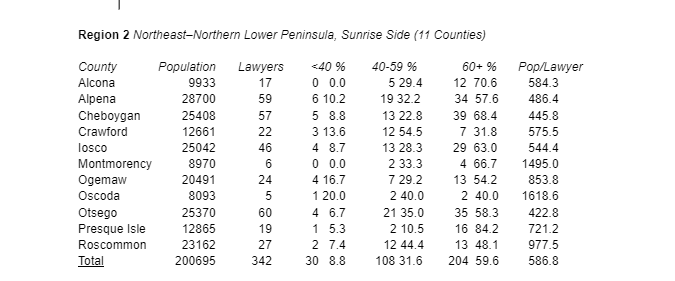 As noted, the OED of the Department of Transportation considers this region to be part of its large North region. As a stand-alone region, it has the lowest population, the lowest number of lawyers, and the lowest number of lawyers under age 40. Slightly less than 60% of its lawyers are 60 or older. It ranks third in the number of persons per lawyer.
As noted, the OED of the Department of Transportation considers this region to be part of its large North region. As a stand-alone region, it has the lowest population, the lowest number of lawyers, and the lowest number of lawyers under age 40. Slightly less than 60% of its lawyers are 60 or older. It ranks third in the number of persons per lawyer.
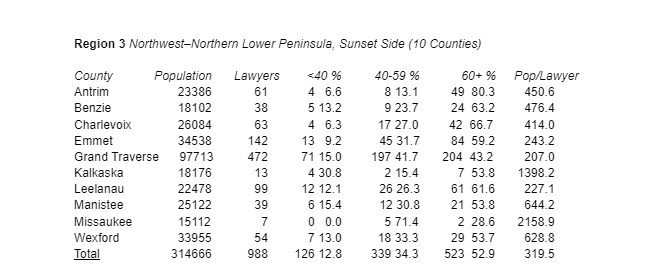
Region 3, the other half of the DOT’s North region, ranks third lowest in population total, number of lawyers, and number of lawyers under age 40 among the regions. It ranks second among the regions in the percentage of its lawyers aged 60 and over, probably due to its number of retirees who remain active members of the bar. Nearly half of this region’s lawyers are resident in Grand Traverse County. Seven of its counties have Lake Michigan shoreline; the other three are landlocked.
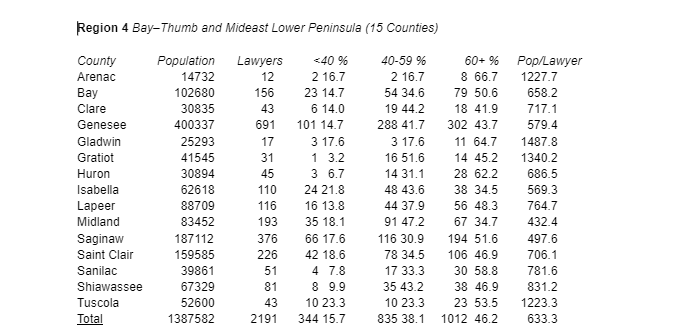
Region 4 is denominated the Bay region by the DOT; its easternmost counties form what is known as Michigan’s “thumb.” The middle of this region includes four larger cities–Saginaw, Bay City, Midland, and Mt. Pleasant; its southern counties feature another major city–Flint. Three counties are home to public universities: Central Michigan University in Isabella County, Saginaw State University in Saginaw County, and the University of Michigan-Flint in Genesee County.
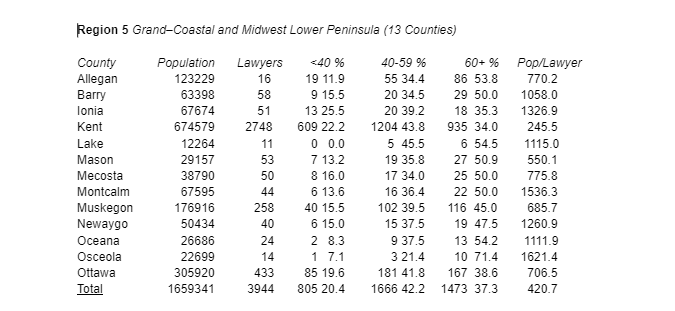 Region 5 was probably called “Grand” because the Grand River empties into Lake Michigan after passing through Michigan’s second-largest city, Grand Rapids (and its fourth-largest county, Kent). This region is exceeded in population only by the Metro region. The cities of Muskegon and Grand Rapids are joined by the growing cities of Zeeland and Holland to form a major population center in west Michigan. The region ranks third in the number of lawyers, second in the percentage of its lawyers under age 40, and has the lowest percentage of lawyers aged 60 or more.
Region 5 was probably called “Grand” because the Grand River empties into Lake Michigan after passing through Michigan’s second-largest city, Grand Rapids (and its fourth-largest county, Kent). This region is exceeded in population only by the Metro region. The cities of Muskegon and Grand Rapids are joined by the growing cities of Zeeland and Holland to form a major population center in west Michigan. The region ranks third in the number of lawyers, second in the percentage of its lawyers under age 40, and has the lowest percentage of lawyers aged 60 or more.
The region is home to two public universities: Grand Valley State University with campuses in Allendale and Grand Rapids, both in Kent County, and Ferris State University in Mecosta County’s Big Rapids. Its northern six counties are mainly rural, with three–Lake, Oceana, and Osceola–having less than 10 percent of its lawyers under age 40 (they have only three lawyers collectively). Five of its counties have shorelines on Lake Michigan.
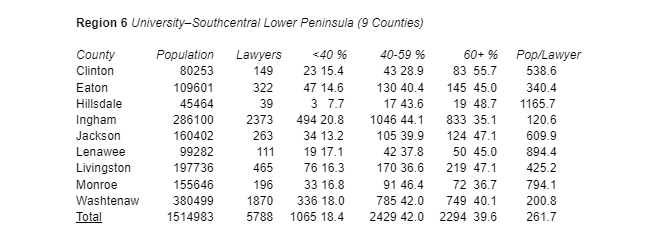
Region 6 is called “University” by the DOT’s Office of Economic Development, likely because it is home to both the University of Michigan and Eastern Michigan University in Washtenaw County, as well as to Michigan State University in Ingham County. It might have been called the “Capitol” region, because it is home to Lansing, the State Capitol. Other than the Metro Region, it has both the most lawyers and the most lawyers in comparison to population.
Four cities in this region form a rough square and population center–Lansing in Ingham County; Jackson in Jackson County, Ann Arbor in Washtenaw County, and Brighton, in fast-growing Livingston County. This region mainly borders Ohio to its south,while it borders Indiana at its southeast corner. It is the only region that touches Lake Erie, although that depends on where the Detroit River ends and Lake Erie begins. The southernmost portion of Wayne County lies where the Detroit River empties into Lake Erie.

Region 7 is the smallest in area and number of counties, but the largest in nearly everything else, including population, number of lawyers overall, and in each of the three age-group categories. It has the most lawyers per person. But its percentage of lawyers aged 60 and over is the second lowest.
Detroit, the region’s largest city, lies to the north and west of Canada. Between Canada and this region lies Lake St. Clair, a mini-Great Lake that is fed by the St. Clair River and, in turn, feeds the Detroit River, which connects to Lake Erie. The region has three public universities–Oakland University in Oakland County and both Wayne State University and the University of Michigan-Dearborn in Wayne County.

Region 8’s seven counties lie in the southwest corner of Michigan; its data lies in the middle of the state’s regions in both numbers and percentages. Two larger cities, Battle Creek and Kalamazoo, form an east-west axis along the region’s northern border. Its southern counties border Indiana, and its two western counties abut Lake Michigan. Western Michigan University is located in Kalamazoo County.
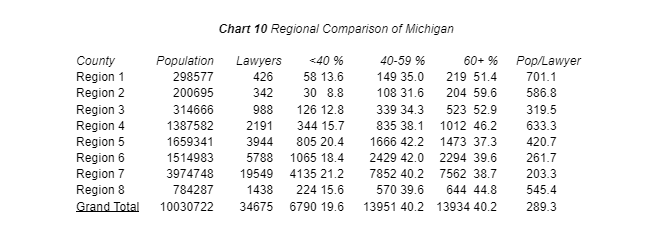
This chart supplies a good summary of the regions. It demonstrates that both Michigan’s general and lawyer populations are mostly concentrated in the southeast, and that the state’s rural-urban divide is captured by the outsized urbanization in Region 7.
Part 7 next examines where Michigan’s lawyers got their education.

